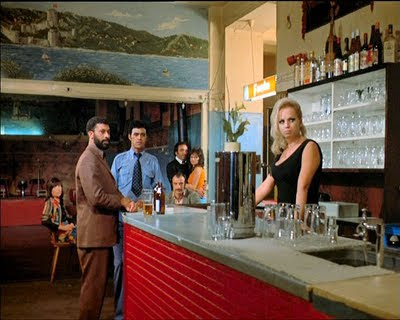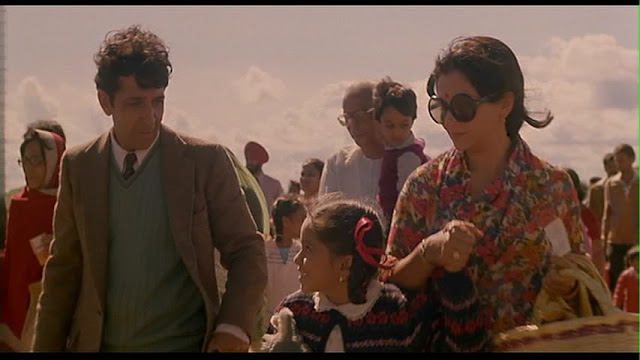 |
| Walter Neff gazing at Phyllis Detrichson. |
Films often have a distinctive masculine or feminine appeal. This often has more to do with marketing. Masculine films could be action films, film noirs, and sports films. Whereas feminine films can be considered romantic comedies and melodramas. Without debating the semantics of masculine and feminine I wish to point out the differences between Film Noir and Melodramas, and the social commentary that they carry with them. The commentary that these two genres have upon society reflects mostly upon the gender roles of society. Both noir and melodramas reflect the poor treatment that women have in society, but they also show that in fact everyone is stuck within tight boundaries of society regardless of sex. The genres also blur the personal with the political, because both are interrelated.
Margarethe von Trotta, Douglas Sirk, and Rainer Werner Fassbinder are all directors of Melodramatic films, and all originate from Germany. They are considered by many to be auteur directors as well, by putting a piece of themselves into their films. Douglas Sirk was influenced by German Expressionistic cinema in his use of framing. Framing was also used by Fassbinder and von Trotta for the use of isolating individuals from the collective group representing society, or entrapping a character. Shohini Chaudhuri writes about Sirk’s influence on Fassbinder, “Sirkian influences also inspire Ali’s mise-en-scene: pools of saturated color in the Asphalt Pub scenes; the use of mirrors, doorways, partitions, and grilles to internally frame characters within the cinematic frame.”2 Von Trotta’s mise-en-scene is described then in a similar way. “Women looking through windows or waiting at windows frequently appear in von Trotta’s films at key moments in characters’ psychological development and their attempts to relate to another--a sister or a friend.” The framing techniques enhance the story being told emotionally by the filmmakers in their films.
 | |
| Ali: Fear Eats the Soul. Here we see the members of the Asphalt pub gazing at Emmi. |
 |
| Here Emmi is juxtaposed so we feel her isolation against the rest of the group. |
Film Noir functions much in the same fashion. The directors of Film Noir either had a background with, or were influenced by German Expressionist cinema as well as the three previously described melodramatic directors. Shots in such films as Robert Aldrich’s Kiss Me Deadly often feature a lone wolf male protagonist against the world. One shot in Kiss Me Deadly features protagonist Mike Hammer being surrounded by a large staircase. Visually, this makes us uneasy by enveloping him in a swirling image. Later we find out that he really is in over his head and caught in the middle of a political storm much bigger than he is. Here is another character who sets out into the world, only to be enveloped by it.
Both Melodramas and Film Noirs feature protagonists that are trying to live by their basic wants or moral codes but find themselves in some way up against society. Chaudhuri states that Sirk’s “melodramas gave Fassbinder a model for making films that could perform ‘a moral critique of an immoral society’” In the concepts of the individual against society, and society’s moral corruption, we come to the point where these two genres mix and engage. Not every Film Noir or Melodrama has societal commentary that is a conscious effort by the filmmakers. Nor do Film Noirs and Melodramas all have the same commentary.
However, regardless of the filmmakers’ intentions, many Film Noirs and Melodramas comment on gender issues. We see this with the femme fatale in noirs, and by the use of a repressed female protagonist in melodramas. Both types of characters can be described in many cases as a female individual who is trying to advance or get ahead in the world on either a grand or micro scale. The femme fatale does so by unscrupulous methods and is therefore ultimately punished. Whereas the melodramatic female character receives societal punishment at some point, she is sometimes also rewarded by a deux ex machina.
Such an ending occurs in Sirk’s All That Heaven Allows, so that we gain the catharsis of the protagonist’s happy ending, but we acknowledge that only by an act of God was this allowed to happen in a morally bankrupt society. Fassbinder took it further by taking out the cathartic ending. Chaudhuri writes, “He designed his films’ closures to create another ‘ending’ in the audience’s head-to make it obvious to them that they must change their lives, even if society restricts their choices.”4 In either case the films are designed so that on some level we are aware of societal flaws and attempt to change them. Noir can also draw attention to societal troubles, Double Indemnity is conscious of the fact that Phyllis Dietrichson somewhat manipulated by society to the point she becomes a cold blooded murderer.
Pessimism arises because it points to the fallacies of the world and attempts to get us to create change. While violence and the male gaze occur in the movie, viewers should not allow them to distract from the overall message of the film. Summing up Fassbinder’s thoughts Chaudhuri states, “‘the cultural representations through which we see and are seen’ should be the focus of our political struggle, not the gaze.” The message of the film should be at the forefront when viewed, because events that occur in the film exist to support the message. The message is political, going back to von Trotta’s view of the interrelation of the personal and political. Many noirs and many melodramas are very feminist in their politics, but are aimed at different audiences. I enjoy both and find them entertaining, because they portray similar outlooks of society.
Bibliography:
Chaudhuri, Shohini. “Ali: Fear Eats the Soul." Film Analysis: A Norton Reader. Ed. Geiger, Jeffrey and Rutsky, R.L. New York: W.W. Norton and Company, 2005.
Haynes, Todd. Far from Heaven, Safe, Superstar: The Karen Carpenter Story; Three Screen Plays. New York: Grove Press, 2003.
Johnston, Claire. “Classic Hollywood Cinema.” Movies and Methods Volume II. Ed. Nichols, Bill. University of California Press: Berkeley and Los Angeles, 1985.
Rueschmann, Eva. “The Politics of Intersubjectivity.” Sisters on the Screen. Philadelphia: Temple University Press, 2000.
Schrader, Paul. "Notes on Film Noir." Film Theory and Criticism. Ed. Braudy, Leo and Cohen, Marshall. 7th ed. New York: Oxford University Press, 2009.
*Note: It should be noted that both Noir and Melodramas had a deep influence by the German Expressionist film movement. Sirk himself came from that background, as well as several other directors and cinematographers of the time. I failed to mention this in the text, and it bears an important part explaining the style similarities of the two genres and their social commentary.









